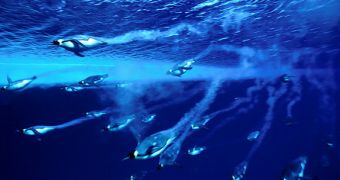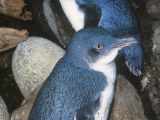1. Since always, penguins have posed a huge issue for taxonomists. No one could say which group of living birds was closest to the penguins, because of their peculiar traits like the wing turned into a flipper and their oddly shaped feathers, which are uniform and resemble small stiff scales. For long, this made biologists place them in their own order, isolated from other birds.
However, the DNA era cleared it all and, to the surprise (or not) of the scientists, these are just ordinary sea birds closely related to loons, albatrosses, petrels, shearwaters, prions, fulmars and frigatebirds. The first penguins appeared 70 Ma ago, at the end of the dinosaur era. The oldest penguin fossil is 40 Ma years old, while most current species appeared in the last 2 Ma.
2. All penguins have lived and continue to live in the Southern Hemisphere. The only penguin to reach the Northern Hemisphere (on the Equator) is the Galapagos penguin (Spheniscus mendiculus), which is also the only equatorial penguin in the world. The explanation is found in the cold current of Humboldt (also called Peruvian), that ascends from Antarctica along the west coast of South America.
There are layers of cold water alternating with layers of warm water around the Galapagos islands. The waters that surround this area are with 8-10o C colder than other equatorial sea waters, having temperatures of 16-22o C, while the sand of the beaches can frequently reach up to 60o C.
3. The largest living penguin is the emperor penguin, which is 30 kg (66 pounds) heavy and 1.20 m (4 ft) tall. It breeds on the coast of Antarctica (66-78o S) but can be found vagrant in New Zealand, Southern South America, Falkland, South Georgia, South Orkney, Kerguelen and the Heard islands.
World's smallest living penguin is the little blue penguin (Eudyptula minor), that is actually as large as a small duck: 1,2 kg (2.5 pounds) and 38 cm (1.2 ft) tall. This penguin nests on dunes and slopes with vegetation in southern Australia (in coastal area from Perth to Newcastle, including Philip Island), Tasmania, New Zealand and the islands Stewart and Chatham.
The largest fossil penguin, Pachydyptes, 30 Ma old, was found in New Zealand: it was 1.6 m (5.5 ft) tall and probably weighed 80-100 kg (180-220 pounds). The older Anthropornis from Antarctica was 1.7 m (5.8 ft) tall and weighed about 90 kg. The 36 Ma old Icadyptes salasi from Peru was 5 ft (1.5 m) tall and had a 7-in (18-cm) long beak.
4. Penguins are famous for their adaptation to cold clime and waters. Besides having a thick insulating fat layer below the skin, they also have three rows of feathers, which are uniformly distributed on their bodies and closely joined together. At a weight of 38 kg, an emperor penguin has 17 kg of fat. 87% of the insulation is ensured by the plumage, 13 % by the body fat.
The circulatory system of the penguins has specialized vessels in wings and feet, which impede the loss of heat. This is a huge issue in the hot summer days, when penguins in southern areas even ingest snow in order to lose heat. Species living at lower latitudes can have bared heads and larger flippers to disperse heat, like the jackass penguin from southern Africa.
The emperor penguin is famous for breeding during the Antarctic winter, surviving for four months at temperatures of -40o C while facing winds of up to 300 km (190 mi) per hour. And all this while fasting! The tight huddling among these penguins, practiced during 50 % of their time spent in the breeding colony, is an important energy-saving behavior. They decrease their metabolism by 25 % during this time by sleeping. While pairing, the body core temperature drops progressively from 37.5?C to 36.5?C. The ambient temperature in a dense huddle rises up to 35?C.
5. Penguins swim using their flipper-like wings, while the feet act like a rudder. While swimming, the wings beat at a rhythm of 120-200 times per minute. They achieve underwater speeds of 36 km (22 mi) per hour that allow them to make jumps out of the water 2 m (6.6 ft) tall and 3 m (10 ft) long.
As an adaptation for swimming, penguins lack pneumatic bones. Penguins are known to swallow stones, which help them both for digestion and when diving.
6.Penguins are the champions of diving in the bird world. On a single breath of air, the emperor penguins can dive as deep as 565 m (1,850 feet) and remain underwater for as long as 28 minutes (an average diving session lasts 6 minutes), in the search of myctophids (lantern fish), deep sea small fishes. It is an absolute record amongst birds. It is believed that, once in the dark deep water, penguins use echolocation, just like dolphins.
The secret is a special hyper-sensitive type of hemoglobin. Some beaked whales can dive to 1,900 m (6,300 ft) depths for 85 minutes, but these are huge mammals, over 10 m (33 ft) long and weighing tons, while these penguins do not overpass 34 kg (75 pounds).
These Antarctic penguins return from long fishing divings with the lowest blood oxygen levels ever recorded in wild animals: they consume virtually all of their oxygen deposits in their respiratory system and blood, when other species would have experienced severe hypoxia.
Most species (humans included) cannot completely consume the oxygen in their lungs, not even when they cannot breathe, because their hemoglobin cannot pick up and transport oxygen in low concentrations, while this penguin hemoglobin seems to be extra-sensitive, squeezing the last oxygen molecules in the birds' breathing system, carrying it to the main oxygen requiring organs (brain and heart).
Higher concentrations of hemoglobin and the blood protein myoglobin allow emperor penguins to store about 2.5 times more oxygen per unit of body mass than humans. The emperor penguins also plummet their heart rate to just five beats per minute on long dives, even when chasing fish, for oxygen preservation.
7. On land, penguins walk at a speed of 1-2 km (0.6-1.2 mi) per hour. The emperor penguins can walk 100 km (60 mi) on land to their breeding colonies, but even the smaller Adelie penguin can finish a 50 km (30 mi) route on ice to its colony.
8. Penguins are particularly vulnerable to oil spills, both because the oil gets into their feathers and because the birds ingest a lot of it. Oil pollution kills tens of thousands of penguins annually.
Gal?pagos penguins are at particular risk as global warming has been producing more El Ni?o phenomena, with catastrophic effects on this species. Polar regions have seen temperatures rise by several degrees in the last century. The slightest change in seawater temperatures affects the ice cover and food availability. Global warming is responsible for the decline by 50 % of the emperor penguin populations over the past 50 years. Fishing nets trap penguins too. The emperor penguin is severely affected by overfishing, which deprives it of food.

 14 DAY TRIAL //
14 DAY TRIAL // 
